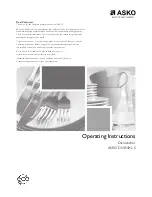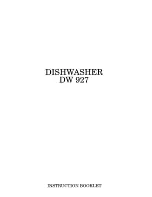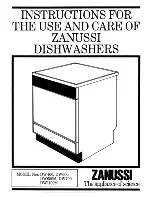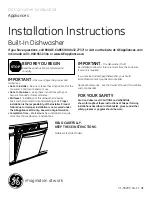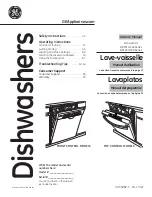
BEFORE WASHING FOR THE FIRST
TIME
WATER SUPPLY
The machine can be connected to either a hot (max. 160 °F, 70
°C) or cold water supply. We recommend a cold water supply.
The water pressure should be 4.2-140 psi. See also the section
Economic dishwashing in the chapter Loading the dishwasher.
CHECKING WATER HARDNESS
Contact the local water utility to check the water hardness in your
area. This is important to determine how much detergent and
rinse aid to use.
TOP UP WITH RINSE AID
Drying is faster if you use rinse aid.
1 Open the rinse aid compartment lid.
2 Carefully top up with rinse aid. Only add rinse aid to the level
marked max.
3 Wipe up any spilled rinse aid around the compartment.
4 Close the lid firmly.
SELECTING THE RINSE AID DOSAGE
The rinse aid dispenser can be adjusted between
(Off) and
(High dosage).
Increase the rinse aid dosage:
• If the dishes have water marks.
Reduce the rinse aid dosage:
• If the dishes have a sticky white/blue film.
• If the dishes are streaked.
• Heavy foaming. If you have very soft water, the rinse aid can
be diluted 50:50 with water.
SETTING THE RINSE AID DOSAGE
The section Settings describes how to set the rinse aid dosage.
REFILL RINSE AID INDICATOR
When the rinse aid needs topping up, the above symbol lights on
the display.
NOTE!
After topping up, it may take a while before the symbol goes
out.
LOADING THE DISHWASHER
ECONOMIC DISHWASHING
Run programs only with a full load
Wait until the dishwasher is fully loaded before running a program,
this way you save energy. Use the Rinse & Hold program to rinse
the dishes if there are any unpleasant odors while you wait for the
dishwasher to become fully loaded.
Run programs at a lower temperature
If the dishes are only lightly soiled, you can select a lower
temperature with certain programs. See also the section Selecting
Options in the chapter Using the dishwasher.
Select a program with Short dry
To save energy, use Short dry. The drying result will be better if,
once the program is finished, you leave the door slightly open.
Do not rinse under running water
Simply scrape off large food particles before loading the
dishwasher.
Choose a green detergent
Read the environmental declaration on the packaging!
Connect to cold water...
If you use oil or electricity to heat your home.
Connect to hot water (max. 160 °F (70 °C))...
If you use district heating, solar power, or geothermal power to
heat your home. Choosing a hot water connection cuts program
times and reduces the dishwasher's electricity consumption.
FRAGILE DISHES
Some cookware is not dishwasher safe. This can be for several
reasons. Some materials cannot withstand high temperatures,
others can be damaged by dishwasher detergent.
Fragile decoration
Porcelain with decoration on top of the glazing (the items feel
rough) should not be washed in a dishwasher.
Crystal/Glass
Position items so that they do not touch each other during the
wash. Use the lowest possible wash temperature and the shortest
possible program. Select Short dry. Antique and very fragile items
should not be washed in a dishwasher.
Glass washed in a dishwasher at high temperatures can gradually
develop a gray film that cannot be removed. Wash fragile glasses
at a low temperature and with a small amount of detergent.
Silver
Silver and stainless steel items should not come into contact, as
the silver can become discolored.
Cutlery with glued handles
Some types of glue are not dishwasher safe. In such cases, the
handles may loosen.
Customer Care Center 1-800-898-1879
www.askousa.com
4

